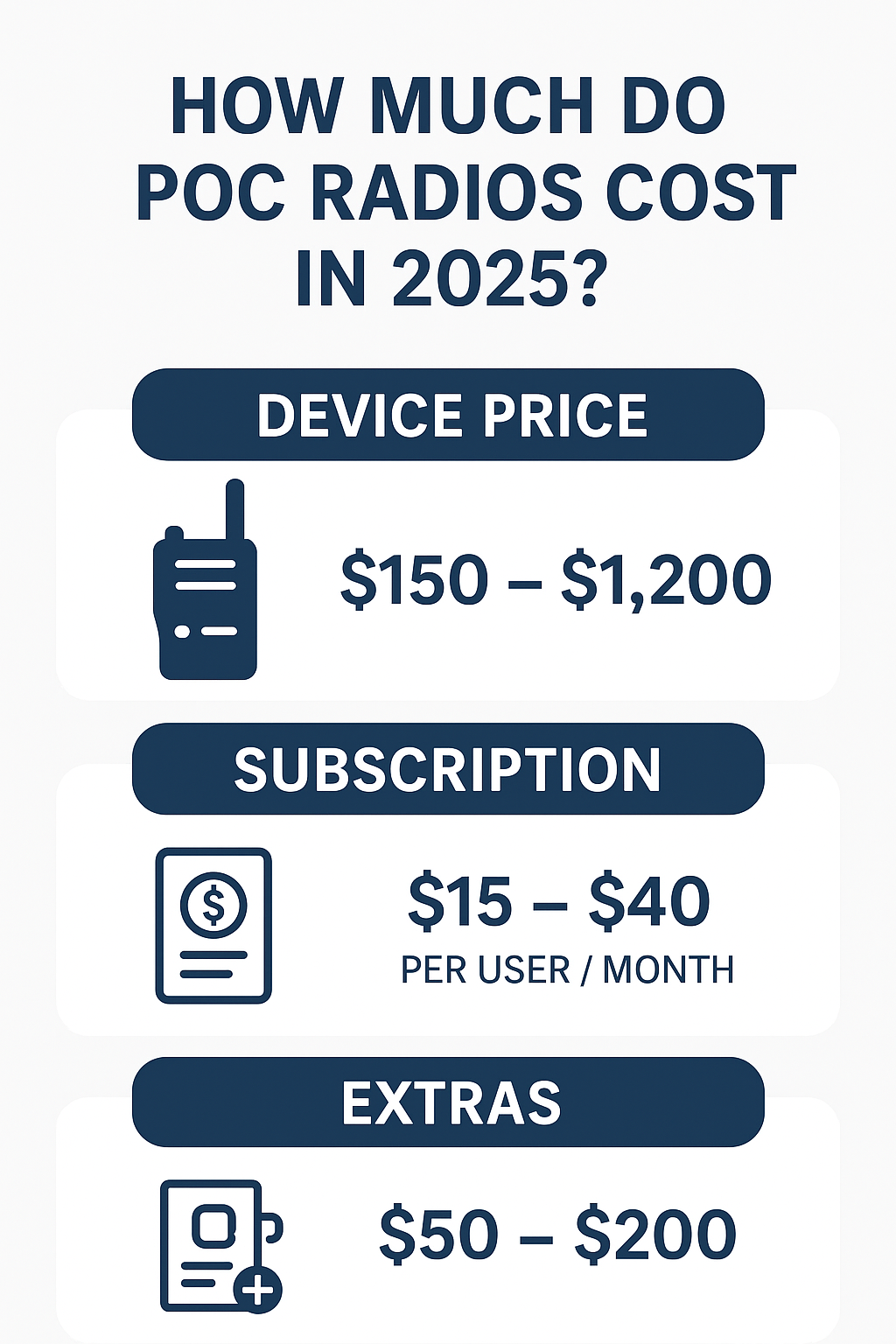
How Much Do Push-To-Talk Over Cellular (PoC) Radios Cost in 2025?
Share
Introduction
When it comes to instant team communication, businesses in security, logistics, transportation, and construction are turning to Push-To-Talk Over Cellular (PoC) radios. Unlike traditional two-way radios limited by range and repeaters, PoC radios use nationwide or global 4G/5G and Wi-Fi networks to keep teams connected.
But one of the first questions decision-makers ask is:
👉 “How much do PoC radios actually cost in 2025?”
The answer isn’t one-size-fits-all. Costs depend on device choice, subscription plans, and feature needs. In this guide, we’ll break down the full cost picture:
- Device prices (entry-level vs premium PoC radios).
- Monthly subscription/service fees.
- Optional extras like accessories and dispatch software.
- The long-term ROI compared to traditional radios.
By the end, you’ll know exactly what budget to set for your security guards, transport fleets, or construction crews — and how to get the best value.
The Core Cost Components of PoC Radios
When budgeting for PoC radios, costs usually fall into three categories:
- Hardware cost (the radios themselves).
- Service subscription (LTE/5G network + PoC platform).
- Add-ons (dispatch systems, accessories, warranties).
Let’s look at each in detail.
1. PoC Radio Device Prices (2025 Guide)
Like smartphones, PoC radios come in different tiers depending on features and ruggedness.
Entry-Level PoC Radios ($150 – $250 per device)
Examples: iTalk 220, Hytera PNC360S.
- Basic 4G + Wi-Fi connectivity.
- SOS/emergency buttons.
- Standard ruggedness (IP54–IP67).
- Long battery life (12–18 hours).
👉 Best for: Small construction crews, budget-conscious security firms.
Mid-Range PoC Radios ($300 – $500 per device)
Examples: Motorola TLK100, Hytera PNC370.
- Stronger durability + better audio.
- Support for dispatch software.
- Nationwide coverage with partner platforms.
- Extended battery and GPS tracking.
👉 Best for: Security patrol companies, logistics fleets.
High-End / Rugged PoC Radios ($600 – $1,200 per device)
Examples: Hytera PNC560, Telo TE590 Plus.
- 5G connectivity + Wi-Fi 6.
- Dual-mode (PoC + smartphone).
- Advanced security (biometrics, encryption).
- Ultra-rugged IP68 with drop resistance.
- High-power speakers for noisy environments.
👉 Best for: Large enterprises, high-security sites, heavy construction, or nationwide transport fleets.
2. Monthly Service & Subscription Fees
Unlike traditional radios that may require frequency licensing or repeaters, PoC radios need a subscription plan for connectivity.
Typical Subscription Costs (2025):
- $15 – $30 per user/month → Basic PoC app + LTE coverage.
- $25 – $40 per user/month → Advanced features (GPS tracking, dispatch integration, encrypted channels).
- $40 – $60+ per user/month → Enterprise-grade plans with unlimited nationwide/global coverage + cloud storage.
💡 Some providers bundle hardware + service into one monthly cost (like leasing). This can be attractive for companies wanting predictable OPEX instead of upfront CAPEX.
3. Optional Add-Ons and Hidden Costs
a. PoC Dispatch Software ($200 – $500/month per console)
For companies with central control rooms, dispatch software allows:
- Group call management.
- GPS tracking of vehicles/guards.
- Instant playback of voice logs.
- Alarm integration.
b. Accessories ($20 – $150 per unit)
- Earpieces & covert kits (popular for security teams).
- Heavy-duty headsets (construction sites).
- Spare batteries & charging docks.
c. Extended Warranties / Support
- 2–3 year warranty extensions add $50–$100 per device.
- Recommended for fleets of 50+ radios to reduce downtime costs.
Cost Comparison: PoC vs Traditional Two-Way Radios
Many companies hesitate about the ongoing subscription fees for PoC radios. But when compared to the costs of traditional UHF/VHF radios, PoC often wins on ROI.
| Cost Factor | Traditional Radios | PoC Radios (2025) |
|---|---|---|
| Hardware | $300–$800 per device | $150–$1,200 per device |
| Licensing Fees | $100–$500/year per radio | None (uses LTE/5G SIMs) |
| Infrastructure | Towers/repeaters ($5K–$20K) | None required |
| Coverage | 1–20 miles (limited) | Nationwide/Global |
| Monthly OPEX | Low, but with hidden fees | $15–$40/user (predictable) |
👉 Bottom line: PoC eliminates licensing and repeater infrastructure, while giving far wider coverage. For nationwide businesses, the total cost of ownership is often lower in the long run.
Real-World Cost Scenarios
To make this practical, let’s map three examples:
Scenario 1: Security Guarding Company (20 users)
- Devices: 20 × Motorola TLK100 @ $350 = $7,000.
- Subscriptions: 20 × $25/month = $500/month.
- Optional earpieces: 20 × $50 = $1,000.
Year 1 Cost: ~$13,000.
Year 2+ Cost: ~$6,000/year in subscriptions.
✅ Affordable entry with predictable monthly cost.
Scenario 2: Logistics Fleet (50 drivers across regions)
- Devices: 50 × Hytera PNC360S @ $250 = $12,500.
- Subscriptions: 50 × $30/month = $1,500/month.
- Dispatch console: $300/month = $1,800/year.
Year 1 Cost: ~$32,300.
Year 2+ Cost: ~$19,800/year.
✅ Lower than building & maintaining a UHF/VHF repeater network.
Scenario 3: Construction Company (100 rugged units)
- Devices: 100 × Telo TE590 Plus @ $800 = $80,000.
- Subscriptions: 100 × $40/month = $4,000/month.
- Accessories (headsets, chargers): $10,000.
Year 1 Cost: ~$138,000.
Year 2+ Cost: ~$48,000/year.
✅ High upfront, but saves downtime + ensures safety across multiple worksites.
ROI: Why Businesses See PoC as Cost-Effective
While the monthly subscription model may feel like an extra burden, PoC radios often deliver strong ROI through:
- Reduced downtime: Clear communication prevents costly delays on construction projects.
- Increased safety: Emergency features lower risks for lone workers or drivers.
- Scalability: Easily add/remove users without licensing headaches.
- Nationwide coverage: One system works across all sites, instead of maintaining multiple local radio systems.
- Lower infrastructure costs: No towers or repeaters needed.
FAQs: Cost-Related Questions About PoC Radios
Q1: Can I use my own SIM cards to cut costs?
Yes, many PoC radios support BYO SIMs. However, you may lose access to integrated dispatch platforms tied to certain providers.
Q2: Are there free PoC apps I can use instead of hardware?
Apps like Zello work on smartphones, but they lack the ruggedness, instant PTT buttons, and battery life of dedicated PoC radios.
Q3: Do PoC radios work internationally?
Yes, with global SIMs or roaming-enabled subscriptions. Costs vary depending on region.
Q4: Can I lease PoC radios instead of buying?
Some providers offer hardware + service bundles (e.g., $40–$60/user/month). This is ideal for companies preferring OPEX over CAPEX.
Final Thoughts
So, how much do PoC radios cost in 2025?
- Devices: $150–$1,200 depending on durability & features.
- Subscriptions: $15–$40 per user/month (higher for advanced plans).
- Extras: $50–$200 per user (accessories, dispatch software, warranties).
For most companies, expect $300–$600 per user in Year 1, then $200–$500 per user annually afterward.
While the recurring subscription might seem steep at first, the payoff is huge: nationwide coverage, better safety, and reduced infrastructure headaches. For security firms, logistics fleets, and construction companies, PoC radios are an investment that pays for itself in efficiency, reliability, and peace of mind.
